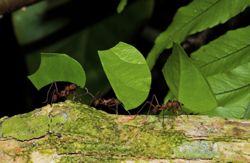Studying Wolbachia infection in ants
Many different types of insects are infected with Wolbachia, but it is not clear what effects, if any, this bacterium has on its host. This is particularly interesting in the case of social insects, as the bacterium may be involved in the evolution of complex social behaviour.The EU-funded SYMBIS project aimed to study the effects of Wolbachia infection on leaf-cutter ant colonies. Leaf-cutter ants were chosen because queens mate with multiple males, allowing comparisons between different genetic lines.Researchers found no difference in resistance to Wolbachia infection between different genetic lines, or between different worker castes. In addition, the behaviour of the ants was affected by genetic differences, but this did not affect resistance to Wolbachia infection.Notably infection rates were very high, between 80 and 100 % in workers — much higher than that found by previous studies. Further research showed that Wolbachia was commonly transmitted between individuals — this is known as horizontal transmission.Taken together, these findings show that Wolbachia, although transmitted between individuals like a disease, has no effect on the health and evolutionary fitness of leaf-cutter ants. This raises further intriguing questions about the role of Wolbachia infection in social insects.







